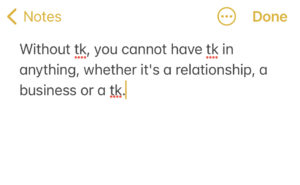
This is the latest article from Neil on writing. If you want to create compelling, unputdownable writing. And feel fulfilled by the process, read on below:
No, that’s not a typo.
It might be your new secret weapon…
Last time, we covered one of three practical tips to support your creative process: Having a sacred space.
These next two will help you fill that space with inspired material, flesh it out with zero latency, and build momentum.
They’re daily staple habits for literally any writer, in any style, which you’ll be able to adopt into your process immediately after reading.
#6: Always be prepared to write down ideas. Anytime, anywhere.
You never know when inspiration is going to come. And usually it comes while you’re not working, when your mind is shut off—on a run, in the shower, or half-asleep.
So have a computer, app, or notepad available to take notes with at all times. And as soon as you get the idea, write it down. You think you’ll remember those amazing ideas, either next work session or next morning, but they almost always disappear forever.
If you found a $100 bill lying on the sidewalk, would you leave it and hope it’s still there when you come back later?
To a writer, ideas are currency. We deal and trade turns of phrase, new connections, memories, stories, and human moments. These are more precious than gold. Treat them accordingly.
Even when I’m out surfing, I use a mnemonic system to remember my ideas until I can get back to shore and write them down. Most often, I use the Memo Pad in my phone. Though I still keep a notebook beside my bed.
Pro tip: If using voice to text or typing quickly, make sure to read and correct your text before closing the app. I’ve lost so many ideas when a phrase like “mention how to unravel the stories we tell ourselves” turned into “mentor Howie understanding outside.”
In the days before smartphones, I actually threaded a string through the spiral binding on a small notepad, and wore it as a necklace. If an idea came while walking down the street, or mid-conversation, I could immediately jot it down and carry on.
Wearing that pad also supported another practice of mine, which is setting my background intent on what I’m writing at all times. If something else is occupying my wandering thoughts, I try to settle it so I reduce the noise and interference with the project at hand.
When you’re not working, and not thinking about a project (yet it’s your highest priority), ideas will come when you’re least expecting them.
#7: Leverage the power of TK.
Those two letters will immediately increase your writing productivity. When you’re in the writing flow and suddenly get stuck on a word, or can’t think of the right fact—don’t stop. Just type “TK,” roll right past it, and come back later to fill it in.
For example:
“She wore a TK expression on her face…” or,
“In 2020, people’s average screen time went up TK percent…”
This keeps your inspiration and thought stream running forward, without hitting the brakes and getting stuck in your head.
Think of TK as a copyediting term that meant “to come.” But since the letters T and K rarely appear together in the English language, it’s much easier to search in digital files. So at the end of your session or draft, you can search the document for “TK” and replace them with the right words, phrases, or bits of research.
If you have to check on the Internet afterward for information, you’ll find you can do all those searches in five minutes, whereas it would have taken two hours if you did them independently each time you hit a research point in writing, and let yourself get distracted.
The key is to keep moving. TK keeps the accelerator pressed down, so you can blast past speed bumps and obstacles, and actually get somewhere.
This is going to come in handy for what’s coming in the next blog post.
I’ll be going deep into how I break down the writing process, especially for big projects. We’ll also dive into how to take on the right TK at the right TK.
For the previous tip click here: https://www.neilstrauss.com/writing/make-it-sacred/
